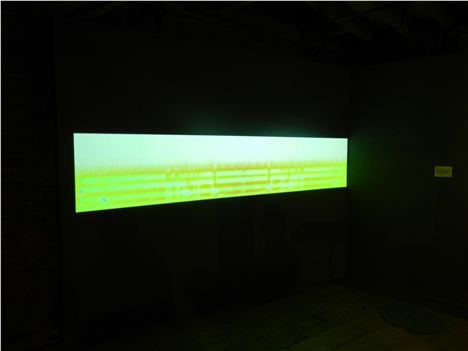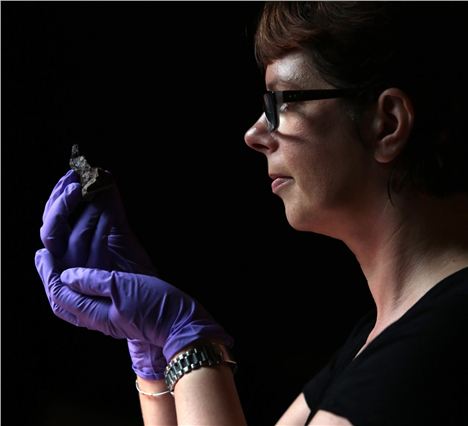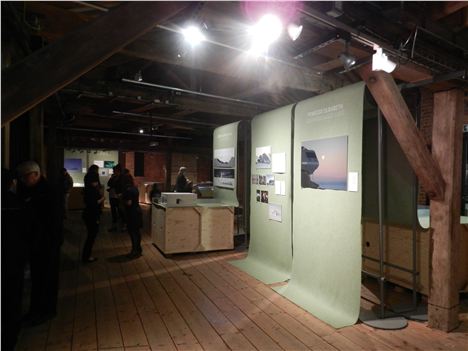THERE'S a really, really old rock at this exhibition.
Granted, at first that may not seem that fascinating, since it looks like a paperweight.
But it’s a 4 billion year old paperweight.
The British Antarctic Survey’s new base, Halley VI (10,000 miles away from the UK), is the world’s first fully relocatable polar research station
Then again every single thing in the Solar System was formed around 4 billion years ago, including Bruce Forsyth, so you may not be overly astonished. And there’s only so long you can stare at a small meteorite. I found this to be in and around the forty three second mark.
41.. 42.. 43.. Done (credit Chris Foster)
Luckily, there’s more to this exhibition than a really old rock.
Ice Lab, commissioned by the British Council and curated by the Arts Catalyst, is the first exhibition to focus on contemporary architecture in Antarctica and features a number of architectural drawings, models, photographs and films that give you a sense of what it’s like to live and work on one of the largest, loneliest, barren but beautiful places on earth. Chilly too I imagine.
Running from 21 October to 6 January, this exhibition opened as part of Manchester Science Festival (Thursday 24 October – Sunday 3 November) features five unique buildings designed to withstand the elements that this frequently brutal continent throws up, from 200mph winds to minus 55 degrees Celsius, while maintaining as little environmental impact as possible.
The exhibits carry an unworldly and bleak appeal; the stations appear like stranded alien space craft on the Star Wars planet of Hoth. Magnificent but chilling in their isolation. The kind of places in which you’d expect Jack Torrance to have a field day.
The British Antarctic Survey’s new base, Halley VI (10,000 miles away from the UK), is the world’s first fully relocatable polar research station – which is handy because the previous five kept disappearing off on icebergs – the new Halley, supported by giant hydraulic legs and supported on huge steel skis which allow it to climb up out of the snow, puts Britain right at the forefront of Antarctic scientific endeavour. There are not so many walking buildings around.
Halley sits alongside four other strikingly innovative and modernist research stations operated by teams from Belgium, India, South Korea and a speculative design by Danish architects for a futuristic station holed out of a large iceberg. An environmental project that would see the station eventually melt back into the ocean at the end of its life course.
Which has vexed Blofeld no end. He's grown tired of the volcano thing.
The exhibit is sound tracked throughout by artist Torsten Lauschmann’s ‘whistlers’, very low frequency electromagnetic waves recorded in Antarctica, which are basically the residue of lightning strikes thousands of miles away and potentially one of the most annoying sounds you’ll hear this side of Louis Walsh.
 Visual representation of the most annoying noise in the world
Visual representation of the most annoying noise in the world
Vicky Richardson, Director of Architecture, Design and Fashion at the British Council, said: “The new wave of Antarctic research stations show the inventiveness in design and engineering required to build in Earth’s most extreme conditions.
“In the same way that scientists from around the world collaborate in Antarctica, these buildings are made possible by cooperation between nations, so it is highly appropriate that the British Council should be commissioning this exhibition, which will tour in the UK before travelling overseas.”
Ice Lab is at the Museum of Science and Industry (MOSI), Liverpool Rd, City centre. M3 4FP. 0161 832 2244
Ice Lab: New Architecture and Science in Antarctica is part of Manchester Science Festival launch on Thursday 24 October. The festival, now in its seventh year, is an eleven day celebration of science produced by the MOSI in partnership with Siemens.
There’s over 150 events taking place all over the city – take a look here.













